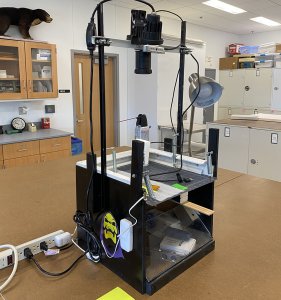Presented By: Ecology and Evolutionary Biology
EEB Virtual Thursday Seminar: Skelevision: understanding temperature-driven morphological variation across space and time using bird skeletal specimens and computer vision
Brian Weeks, Assistant Professor, U-M SEAS

Our weekly seminar series featuring internal and external speakers in the field of ecology and evolutionary biology.
Image caption: By reducing handling time, this machine - affectionately called the bone dumper - made it feasible to rapidly photograph >14,000 bird skeletons in the UM ornithology collections. Using a computer vision approach to identify and measure traits on particular bones in the photographs, it has been possible to generate a large-scale functional trait dataset based on these images.
Image caption: By reducing handling time, this machine - affectionately called the bone dumper - made it feasible to rapidly photograph >14,000 bird skeletons in the UM ornithology collections. Using a computer vision approach to identify and measure traits on particular bones in the photographs, it has been possible to generate a large-scale functional trait dataset based on these images.
